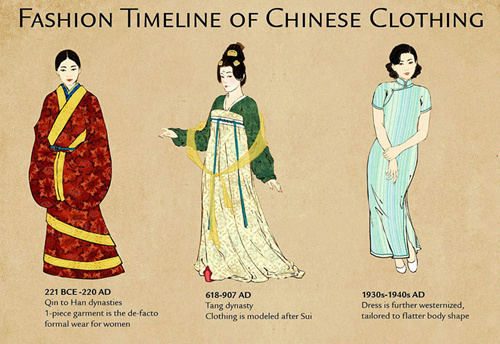As China evolved, so did its fashion
Author : GAO HAIYING Source : Chinese Social Sciences Today 2017-04-25

Traditional Chinese clothing experienced various changes through history. The changes enriched the design of Chinese clothes.
Traditional Chinese clothing continuously absorbed elements of various costume cultures throughout its varied history. These varied influences greatly enriched the design of traditional Chinese costumes.
Every dynasty adopted its own elements for their style of dress, and changes in each dynasty brought about changes in apparel and accessories. When Shen Congwen, a modern Chinese writer and litterateur, compiled The Study of Ancient Chinese Costumes, he indicated that the incumbent emperor often commanded his subjects to wear what the last emperor recommended.
The evolution of costumes is a complicated process. In the case of Chinese clothing, traditional Chinese costumes, including Hu clothing, Tang suits and clothes of the Manchu nationality, underwent various changes when absorbing elements of other ethnic clothing. Hu clothing is a general term for what non-Han nationalities wore in ancient western and northern China. Due to territorial changes, the term “Hu clothing” later referred to the close of different ethnic minorities in each dynasty.
Zhou Xibao, a renowned expert on traditional Chinese clothing, once said that Chinese clothing experienced five major changes in history and the last one happened in the modern era.
Based on the historical records, the first change occurred during the Warring States period. Due to political and military requirements, King Wuling of Zhao State encouraged his subjects to wear Hu clothes and shoot from horseback. He introduced the hunting style of trousers, belt hooks and boots from hunting groups of ethnic minorities in Northwest China to the Central Plains. This revolution changed the dress style of the Han nationality, particularly the wearing of trousers instead of skirts. So it was more convenient for people to ride horses in battle, which strengthened the state.
The Study of Ancient Chinese Costume indicates that a complete system of Chinese clothing was established in the Han Dynasty. The technologies of dyeing, embroidery and metalwork developed rapidly at that time, driving changes in costumes and adornments. In the late Han Dynasty, the royal court declined and China began to enter into the Wei, Jin and Southern and Northern periods, when the nation was caught in the secession and political upheaval. In these periods, non-Han nationalities successively established courts in the Central Plain, and it was very common for different nationalities to communicate and blend in. Some ethnic nationalities integrated with the Han nationality, so it became commonplace to see blends among different ethnic costumes. Zhu Xi, a philosopher in the Song Dynasty, once commented that what Song royal officials wore were actually ethnic nationalities’ military uniforms which were brought into the Central Plains during the Wei, Jin and Southern and Northern periods. This represented the second substantial change in the history of traditional Chinese clothing.
The third took place in the Tang Dynasty. It was a prosperous and open period in Chinese history. It became fashionable for both the nobility and ordinary people to wear Hu clothes and hats. Also, the accessories of the Western Regions, including today’s Xinjiang Autonomous Region and parts of Central Asia, were introduced to the Central Plains, which was the result of the Tang Dynasty’s international cultural exchanges.
When the Manchu nobility established the Qing Dynasty, they commanded Han people to wear the traditional hairstyle and garments of the Manchu nationality. This harsh order, a means of political control and oppression, greatly changed Han people’s dress style by making the Manchu robe and surcoat the main Chinese clothing style, which then became a symbol of Chinese culture in most Westerners’ eyes. This was the fourth change in the traditional Chinese costume style.
The last one occurred after the Revolution of 1911. Suits and other Western style clothes were in vogue, representing the revolt of the New Culture Movement in 1919 against traditional feudal robes and jackets.
Ye Shengtao made Chinese fairy tales from a wilderness
Ye Shengtao (1894–1988) created the first collection of fairy tales in the history of Chinese children’s literature...
-
How northern ethnicities integrated into Chinese nation
2023-09-18
-
Mogao caves
2023-09-12
-
Mogao Grottoes as ‘a place of pilgrimage’
2023-09-12
-
Time-honored architectural traditions in China
2023-08-29
-
Disentangling the civilizational evolution of China
2023-08-28
-
AI ethics in science fiction
2023-08-23














 2011-2013 by www.cssn.cn. All Rights Reserved
2011-2013 by www.cssn.cn. All Rights Reserved